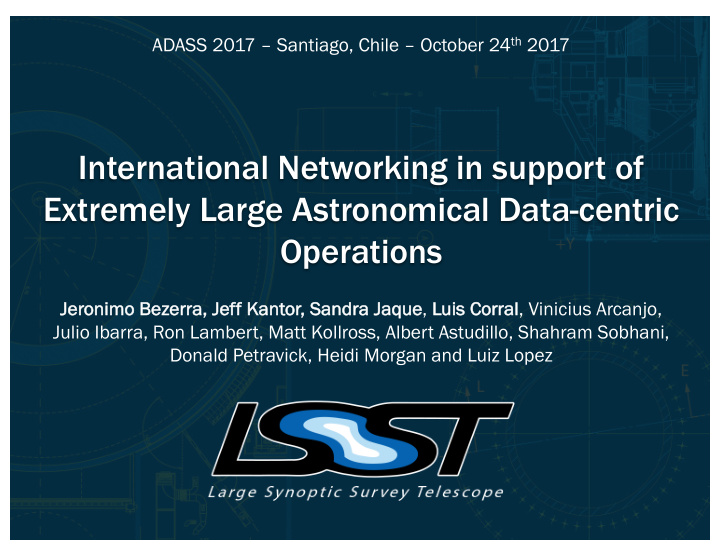



ADASS 2017 – Santiago, Chile – October 24 th 2017 International Networking in support of Extremely Large Astronomical Data-centric Operations Je Jeronimo Bezerra rra, Je Jeff Kantor, Sandra ra Ja Jaque , Lu Luis Corral , Vinicius Arcanjo, Julio Ibarra, Ron Lambert, Matt Kollross, Albert Astudillo, Shahram Sobhani, Donald Petravick, Heidi Morgan and Luiz Lopez
Outline A bit of history: international networks in South America to • support astronomical operations A bit of future: the Large Synoptic Survey Telescope • Key Challenges for Inter-Domain provisioning to support • extremely large astronomical data-centric operations LSST Network Engineering Team Goals • Conclusion • ADASS 2017 – OCT 24 2017 – SANTIAGO, CHILE 2
A bit of past : networking needs Back in the 90s, high-bandwidth connections (256kbps) were used for basic communication and coordination: Satellite connections for point-to-point connection • Data was shipped via Fedex • In the 2000+, high-bandwidth links (45 – <1Gbps) were used for data transfer in a very limited fashion: In 2011, Chile was home to 42% of the world's astronomical • infrastructure It was still not unusual to have data shipped via Fedex • In South America, projects such as AURA, GEMINI, ALMA, NOAO and • others started demanding more network capacity Many projects and partnerships were created to deal with this • demand for networking capacity, for example, the Americas Lightpaths (AmLight) project, that connects South America to the U.S. In 2013, at AmLight, 20+ Gbps of total capacity was available in • Chile to support data transfers. ADASS 2017 – OCT 24 2017 – SANTIAGO, CHILE 3
A bit of future: Large ¡Synoptic ¡Survey ¡Telescope Composed ¡of ¡ multiple Data ¡ Management ¡facilities Multiple ¡data ¡streams ¡summing ¡up ¡90 ¡ Gbps: ¡ Every ¡30 ¡seconds ¡during ¡ observing, ¡a ¡12.7GB ¡data ¡set ¡ must ¡be ¡transmitted ¡from ¡La ¡ Serena ¡to ¡the ¡U.S. ¡in ¡5 ¡seconds! The ¡path ¡created ¡from ¡the ¡Base ¡Site ¡to ¡ Archive ¡Site ¡is ¡composed ¡of ¡multiple ¡ academic ¡networks ¡with ¡multiple ¡high ¡ bandwidth ¡links The ¡end-‑to-‑end ¡path ¡must ¡provide ¡ high ¡resilience, ¡low ¡delay, ¡and ¡ an ¡efficient ¡control ¡plane ¡to ¡act ¡in ¡all ¡network ¡status ¡changes!! ADASS 2017 – OCT 24 2017 – SANTIAGO, CHILE 4
Challenges… ADASS 2017 – OCT 24 2017 – SANTIAGO, CHILE 5
Inter-Domain Coordination Leveraging multiple academic network operators has many advantages: Academic networks are usually more flexible for complex • requirements Shared costs help lower the total cost per Mbps • However, it has challenges: Each academic network might have a completely different • technology, configuration or vendor making interoperability complex Most academic networks rely on static provisioning and multi- • domain provisioning can easily take weeks to be completed ADASS 2017 – OCT 24 2017 – SANTIAGO, CHILE 6
Inter-Domain Coordination [2] The LSST network is being created with multiple 100G links involving many academic networks: REUNA • AmLight • CLARA • ANSP • RNP • FLR • Internet2 • ESNet • StarLight • NCSA • ADASS 2017 – OCT 24 2017 – SANTIAGO, CHILE 7
High Delay*Bandwidth Product The ”distance” (delay) from La Serena to Champaign, Illinois varies from • 140ms (primary path) to 280ms (backup path) Most Layer 4 Transport protocols (including TCP) were not made to operate • with such long delay 0.001% of packet loss with this delay is enough to kill a data transfer: • Performance Measurement is key in this kind of environment • ADASS 2017 – OCT 24 2017 – SANTIAGO, CHILE 8
Performance Measurement perfSonar framework is the primary solution for performance measurement in the academic community More than 2000 installations • To measure end-to-end performance, each domain has its own nodes sending results to a centralized measurement archive: Maddash • ADASS 2017 – OCT 24 2017 – SANTIAGO, CHILE 9
Networking Requirements Even with no errors, our job as network engineers is not done: Best Effort & Bursts are always testing us! The LSST network requirements specifies different traffic types with minimum bandwidth reservation when using shared infrastructure A complex inter-domain QoS framework is being • evaluated An ”almost deterministic” network is the main goal. ADASS 2017 – OCT 24 2017 – SANTIAGO, CHILE 10
Next Steps… ADASS 2017 – OCT 24 2017 – SANTIAGO, CHILE 11
LSST NET Goals Centralized Network Monitoring System will track all domains and network layers (optical and packet) Performance Measurement: multiple perfSonar nodes at 100G! Network Automation as much as possible for future provisioning activities Better interfaces for researchers: Software-Defined Exchanges ADASS 2017 – OCT 24 2017 – SANTIAGO, CHILE 12
Conclusion Deploying an international network to support data-centric operations is challenging but possible! LSST Network Engineering Team includes network engineers and operators from domains in the path Meetings every month A lot of coordination in the present to automate the future! ADASS 2017 – OCT 24 2017 – SANTIAGO, CHILE 13
Acknowledgement This material is based upon work supported in part by the National Science Foundation through Cooperative Agreement 1258333 managed by the Association of Universities for Research in Astronomy (AURA), and the Department of Energy under Contract No. DE-AC02-76SF00515 with the SLAC National Accelerator Laboratory. Additional LSST funding comes form private donations, grants to universities, and in-kind support from LSSTC Institutional Members. ADASS 2017 – OCT 24 2017 – SANTIAGO, CHILE 14
ADASS 2017 – Santiago, Chile – October 24 th 2017 Th Thank nk y you! u! Questi Qu stion ons? s? International Networking in support of Extremely Large Astronomical Data-centric Operations , Vinicius Arcanjo, Jeronimo Bezerra Je rra, Je Jeff Kantor, Sandra ra Ja Jaque, L , Luis C Corral, Julio Ibarra, Ron Lambert, Matt Kollross, Albert Astudillo, Shahram Sobhani, Donald Petravick, Heidi Morgan and Luiz Lopez
Recommend
More recommend